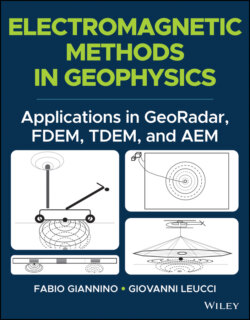Читать книгу Electromagnetic Methods in Geophysics - Fabio Giannino - Страница 21
2.2.3. The “Low Induction Number” Condition
ОглавлениеLet us consider a transmitting coil laying horizontally oriented with respect to the soil surface (vertical dipole mode), and a receiving coil, still in a vertical dipole mode, located at a (short) distance s from the transmitter coil, as sketched in figure 2.2.3.
Figure 2.2.4 Sketch of the phase relation between the primary and the secondary EM field. 1) P is the primary, S the secondary and R represents the resulting EM field; es is the EM induced field. 2) phase difference between two wave form
(modified from F. Giannino, 2014).
Figure 2.2.5 Sketch of the response of the Real component (solid line) and the Imaginary component (dashed line), as the ratio R/ω varies
(modified from F. Giannino, 2014).
When an alternating current flows within the transmitter coil, to this electric current is associated a magnetic field which, in turn, induces eddy current, in the subsoil; to the eddy currents, as in the case of the primary field, is associated a secondary magnetic field, that is sensed (detected) by the receiver coil, together with the primary magnetic field due to the primary electric field.
The secondary magnetic field, is a complex function of the transmitting and receiving coils spacing (s), of the transmitter frequency (f), and of the subsoil conductivity σ.
Under specific conditions, defined as operations at low induction number, it can be observed that the secondary magnetic field becomes a function of the above‐mentioned variables, easier to handle (J.D. McNeill, 1980, ASTM D6639‐01, 2008):
In 2.2.12, Hs is the secondary magnetic field, Hp is the primary magnetic field, ω is the angular frequency (2πf), f is the frequency of the primary, μ0 is the magnetic permittivity in the free space, σ the electrical conductivity, s is the transmitting and receiving coil spacing, and .
As the above terms are either known or measured by any ground conductivity‐meter, it follows that the apparent electrical conductivity of the subsoil can easily be computed, via:
In order to have an explanation of the above, Figure 2.2.6 should be considered.
In both cases shown in Figure 2.2.6 (1 and 2), an alternating electric current of frequency f (in Hz), circulate within a transmitting coil, and the quantity actually measured at the receiver coil (Rx in Figure 2.2.6) is the ratio between the secondary and the primary magnetic field, hence Hs/Hp. The mathematical equations allowing for the computation of this ratio, either for the vertical dipole mode (Figure 2.2.6– 1) as well as for the horizontal dipole mode (Figure 2.2.6– 2), are:
In (2.2.14), (vertical dipole mode) and 2.2.15, (horizontal dipole mode), s is the transmitting and receiving coil spacing, γ, ω=2πf, f is the frequency, μ0 is the magnetic permittivity in the free space, and .
Both (2.2.14) and (2.2.15), are rather complex functions of γs.
Under certain conditions, these two functions may be simplified, and they conduct back to the equation (2.2.13).
In order to explain the above (and to reach to the justification of the Low Induction Number conditions), let us consider one of the subsoil characteristics is the so‐called skin depth.
The skin depth is the distance from the EM source (depth) where the amplitude of a signal propagating through a homogeneous half‐space, reduces to 1/e with respect to the amplitude of the original signal emitted by the EM source itself.
The skin depth is denoted by δ, and can be written as:
(2.2.16)
It follows that,
(2.2.17)
Figure 2.2.6 Vertical dipole (1) and horizontal dipole (2) FDEM data acquisition mode
(modified from J.D. McNeill, 1980).
In (3.2.17) the ratio is the so‐called induction number and it is denoted by B: at condition that B is very small (B<<1), and that the transmitting and receiving inter‐coil distance is very little with respect to the skin depth, (2.2.14) and (2.2.15) reduces to (3.2.13),
(2.2.18)
By resolving (3.2.18) with respect to σ, this brings back to 2.2.13,
A function that can be used alternatively for the computation of the skin depth is (P.V. Sharma, 1997):
(2.2.19)
Here ρ represents the electrical resistivity (Ω m), or the inverse of the electrical conductivity σ (σ =1/ ρ).
Under these operative conditions, that is when the inter‐coil spacing between the transmitter and the receiver is very small compared to the possible skin depth, the above approximation may be considered applicable and it facilitate the computation of the subsoil apparent conductivity.
The architecture of modern ground conductivity meters is based on the above principle, and systems are built to respects to above parameters to “work” under these conditions.
Let us verify whether, under common site conditions that may be found during any FDEM data acquisition campaign, the validity of the low induction number hypothesis, may apply. To do this, let us imagine a homogeneous half‐space of 100 mS/m electrical conductivity σ; the frequency of the EM signal emitted by the transmitting coil being of 10 KHz and the spacing between transmitting and receiving coil 4 meters.
The greatest part of the geological material shows magnetic permittivity equal to 4*10−7 H/m.
Under the above conditions we shall have a skin depth value equal to:
Hence, a EM signal propagating at a frequency of 10 KHz, within a half‐space having 100 mS/m electrical conductivity, will attenuate of the quantity 1/e at a depth that is equal to 16 meters (skin depth).
Because we assumed that the inter‐coil spacing equals 4 meters, then B, the induction number equals to:
As B is small enough than the hypothesis relating with the low induction number that led to the formulation of (measured voltage e(t) varies in 2.2.13), can be considered valid.
